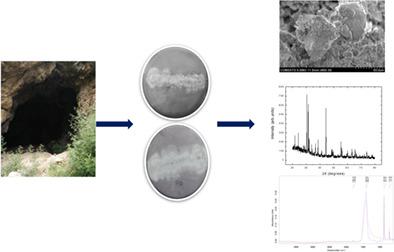当前位置:
X-MOL 学术
›
Microsc. Res. Tech.
›
论文详情
Our official English website, www.x-mol.net, welcomes your
feedback! (Note: you will need to create a separate account there.)
Calcium carbonate precipitation by cave bacteria isolated from Kashmir Cave, Khyber Pakhtunkhwa, Pakistan
Microscopy Research and Technique ( IF 2.0 ) Pub Date : 2022-04-06 , DOI: 10.1002/jemt.24105 Saeed Ullah Jan 1 , Sahib Zada 2 , Muhammad Rafiq 3 , Imran Khan 1 , Wasim Sajjad 4 , Muhammad Anwar Khan 5 , Fariha Hasan 1
Microscopy Research and Technique ( IF 2.0 ) Pub Date : 2022-04-06 , DOI: 10.1002/jemt.24105 Saeed Ullah Jan 1 , Sahib Zada 2 , Muhammad Rafiq 3 , Imran Khan 1 , Wasim Sajjad 4 , Muhammad Anwar Khan 5 , Fariha Hasan 1
Affiliation

|
The participation of numerous physicochemical and biological functions maintains the evolution and expansion of the remarkable nature. Due to its vast applicability in several engineering disciplines, naturally occurring bio-mineralization or microbially induced calcium carbonate (MICP) precipitation is attracting more interest. Cave bacteria contribute to the precipitation of calcium carbonate (CaCO3). In the present study, soil sediments were collected from Kashmir cave, KPK, Pakistan, and plated on B4 specific nutrients limited medium for bacterial isolation and the viable bacterial count was calculated. Three bacterial strains named GSN-11, TFSN-14, and TFSN-15 were capable of precipitating CaCO3. These bacterial isolates were identified through 16S rRNA gene sequencing and strain GSN-11 was identified as Bacillus toyonensis, TFSN-14 as Paracoccus limosus and TFSN-15 as Brevundimonas diminuta. Enhanced CaCO3 precipitation potential of these bacteria strains was observed at 25°C and pH 5. The precipitated CaCO3 was confirmed by scanning electron microscopy, X-ray powder diffraction, and Fourier transform infra-red spectroscopy. The findings showed that the precipitates were dominated by calcite, aragonite, and nanosize vaterite. Current research suggests that precipitation of CaCO3 by proteolytic cave bacteria is widespread in Kashmir cave and these bacterial communities can actively contribute to the formation of CaCO3 by enhancing the pH of the microenvironment.
中文翻译:

从巴基斯坦开伯尔普赫图赫瓦省克什米尔洞穴中分离的洞穴细菌的碳酸钙沉淀
众多物理化学和生物功能的参与,维持着非凡性质的进化和扩展。由于其在多个工程学科中的广泛适用性,自然发生的生物矿化或微生物诱导的碳酸钙 (MICP) 沉淀引起了更多的兴趣。洞穴细菌有助于碳酸钙(CaCO 3)的沉淀。在本研究中,从巴基斯坦 KPK 的克什米尔洞穴收集土壤沉积物,并将其铺在 B4 特定营养素限制培养基上进行细菌分离,并计算活细菌计数。三种名为 GSN-11、TFSN-14 和 TFSN-15 的细菌菌株能够沉淀 CaCO 3. 这些细菌分离物通过16S rRNA基因测序鉴定,菌株GSN-11被鉴定为Bacillus toyonensis,TFSN-14被鉴定为Paracoccus limosus,TFSN-15被鉴定为Brevundimonas diminuta。在 25°C 和 pH 值 5 下观察到这些细菌菌株的CaCO 3沉淀潜力增强。通过扫描电子显微镜、X 射线粉末衍射和傅里叶变换红外光谱证实了沉淀的 CaCO 3 。结果表明,析出物以方解石、文石和纳米球霰石为主。目前的研究表明,CaCO 3的沉淀通过蛋白水解洞穴细菌在克什米尔洞穴中广泛存在,这些细菌群落可以通过提高微环境的 pH 值积极促进 CaCO 3的形成。
更新日期:2022-04-06
中文翻译:

从巴基斯坦开伯尔普赫图赫瓦省克什米尔洞穴中分离的洞穴细菌的碳酸钙沉淀
众多物理化学和生物功能的参与,维持着非凡性质的进化和扩展。由于其在多个工程学科中的广泛适用性,自然发生的生物矿化或微生物诱导的碳酸钙 (MICP) 沉淀引起了更多的兴趣。洞穴细菌有助于碳酸钙(CaCO 3)的沉淀。在本研究中,从巴基斯坦 KPK 的克什米尔洞穴收集土壤沉积物,并将其铺在 B4 特定营养素限制培养基上进行细菌分离,并计算活细菌计数。三种名为 GSN-11、TFSN-14 和 TFSN-15 的细菌菌株能够沉淀 CaCO 3. 这些细菌分离物通过16S rRNA基因测序鉴定,菌株GSN-11被鉴定为Bacillus toyonensis,TFSN-14被鉴定为Paracoccus limosus,TFSN-15被鉴定为Brevundimonas diminuta。在 25°C 和 pH 值 5 下观察到这些细菌菌株的CaCO 3沉淀潜力增强。通过扫描电子显微镜、X 射线粉末衍射和傅里叶变换红外光谱证实了沉淀的 CaCO 3 。结果表明,析出物以方解石、文石和纳米球霰石为主。目前的研究表明,CaCO 3的沉淀通过蛋白水解洞穴细菌在克什米尔洞穴中广泛存在,这些细菌群落可以通过提高微环境的 pH 值积极促进 CaCO 3的形成。













































 京公网安备 11010802027423号
京公网安备 11010802027423号